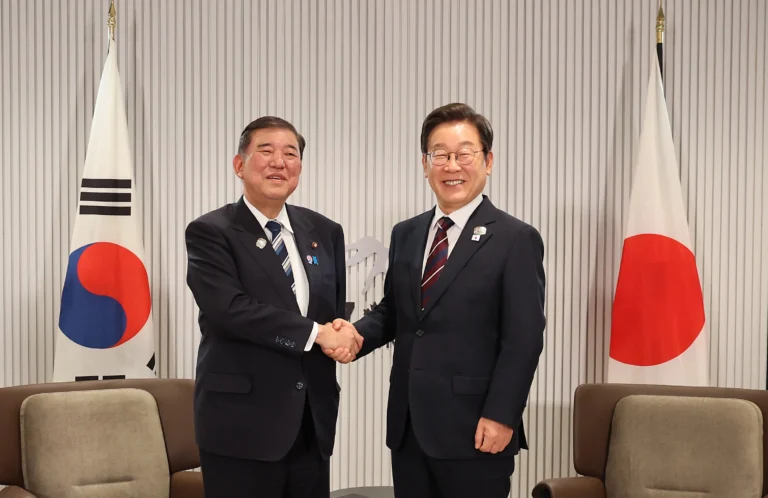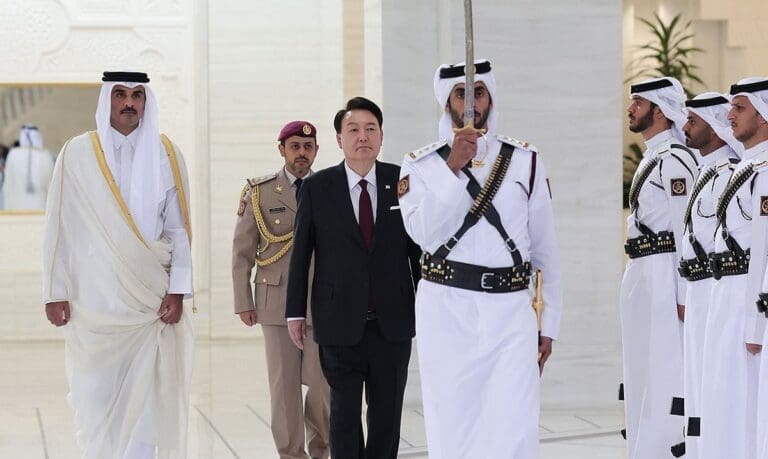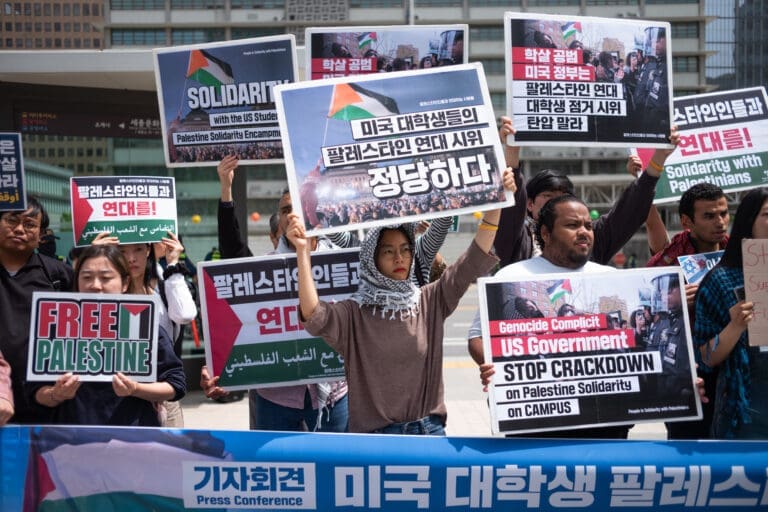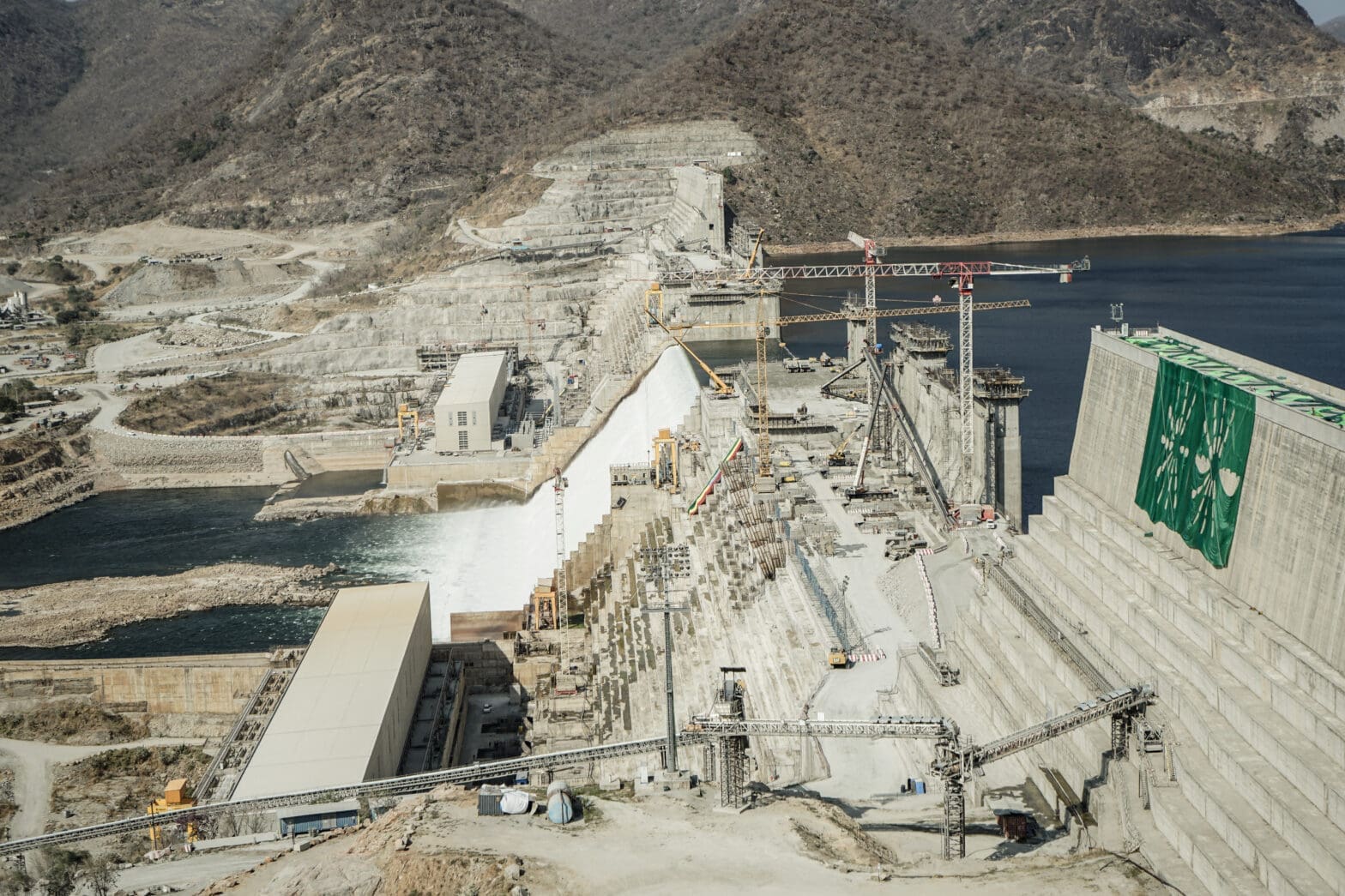
Water Diplomacy:
How to Prevent Water Wars in the MENA Region
Issue Brief, January 2025
Key Takeaways
Water diplomacy is key to building trust: Water diplomacy is deteriorating in the MENA region, but if the appropriate forum is provided and there is sufficient political will, states can resolve their water disputes through sustained diplomacy.
Arab countries are often at a disadvantage in water diplomacy: Most major rivers in the Arab region (including the three biggest: the Nile, Tigris, and Euphrates) originate outside the region, giving downstream Arab countries little control or leverage over the flow of these rivers.
Upstream countries should not see water allocation as a zero-sum game: States such as Türkiye and Ethiopia are better served by long-term stability reached through compromise with their downstream neighbors than unilateral action, which often causes animosity.
Desalination cannot replace freshwater resources: Despite advances in desalination technology, it cannot replace rivers, lakes, and aquifers, which will remain vital for meeting long-term agricultural and industrial water demand. Therefore, these freshwater resources must be managed sustainably.
Introduction
Water scarcity across the Middle East and North Africa (MENA) continues to be one of the most critical challenges facing the region, with far-reaching implications for development, security, and stability. The MENA region is home to 15 of the 20 most water-scarce countries in the world, with per-capita potable water availability significantly below the global average.1 This is exacerbated by insufficient water governance mechanisms, persistent mistrust between state actors, and disagreements on how to share and manage regional, transboundary water resources, such as rivers and aquifers.
Most countries in MENA have resorted to desalination to mitigate the destabilizing effects of water scarcity. However, desalination is only a partial solution that cannot entirely replace existing freshwater resources. Therefore, tensions over limited freshwater resources will continue, primarily in agriculturally and industrially productive areas of MENA, and especially if regional leaders and multilateral organizations fail to adopt diplomatic, cooperative approaches to managing transboundary river basins2 and aquifers.3This Issue Brief argues that MENA countries and their neighbors should enhance cooperation over water resources to avert future conflict. Such cooperation will be critical to safeguarding the long-term stability of the region and ensuring sustainable water management.
Scarce, Transboundary Resources Pose Governance Challenges
The long-term impacts of water scarcity across the MENA region are multifaceted and profound. Firstly, water scarcity will pose significant threats to food security, given its impact on agricultural production.4 Secondly, it will affect economic development and growth,5 although the negative impacts can be mitigated with responsible policies on water use and distribution.
In addition to being by far the most water-scarce region in the world, the MENA region is also the most reliant on transboundary water resources (i.e. those shared by two or more countries across geopolitical borders).6 As the United Nations’ (UN) World Water Development Report 2024 notes, transboundary and cross-sectoral cooperation is “of crucial importance to the (Arab) region.”7
One factor preventing cooperation over water resources is the ineffectiveness of existing multilateral water governance institutions, such as the Arab Water Council or the Council of Water Ministers at the League of Arab States. There are also a handful of localized, multilateral mechanisms in the region that help govern or regulate a particular river basin or aquifer, such as the Nile Basin Initiative and the Jordan-Saudi Agreement on the management and utilization of the Al-Saq/Al-Disi transboundary aquifer. These are instructive examples, as they offer valuable lessons regarding best practices for transboundary water governance. However, major institutional gaps remain in the region’s water governance infrastructure, such as in the Tigris-Euphrates basin,8 where no multilateral organization exists to facilitate cooperation and resolve disputes.
In the coming decades, water scarcity will be further exacerbated by the combined effects of climate change, poor governance, and state fragility, potentially sparking conflict. Such fears have loomed large in recent years amid rising tensions between Egypt and its key upstream rival, Ethiopia. Similar dynamics apply to other states in the region such as Iraq, which has experienced tensions in the past with Türkiye over the Euphrates and Tigris rivers, and Jordan, which has had long-standing disagreements with Syria over the Yarmouk River, a major tributary of the Jordan River. However, this paper argues that the region can avoid future water wars through further diplomacy and engagement.
Figure 1: Freshwater withdrawals as a share of internal resources by country, 2021.
Food and Agriculture Organization of the United Nations, World Bank Official Boundaries • Five Classes have been identified to signal different levels of stress on water sources: <25%: no stress; 25-50%: low stress; 50-75% medium stress; 75-100% high stress; >100%: critical stress. CC BY.9
MENA Rivers, Aquifers, and Water Scarcity
The region’s three longest rivers—the Nile, Euphrates, and Tigris—are critical sources of freshwater. They have been depleted not only due to climate change, but also by overextraction and mismanagement caused by transboundary water-sharing challenges10 the administrative difficulties created wherever a large river basin or aquifer is shared by two or more countries. In addition to overextraction, rivers in MENA region have suffered from the excessive construction of dams (Türkiye alone has plans to build 22 dams along the Euphrates and Tigris rivers,11 of which 19 were already built by 2022),12 pollution, and saltwater intrusion.13 Add to that the regional geopolitical tensions and the situation risks becoming increasingly combustible.
Figure 2: Internal Renewable Freshwater Resources by Region, 2020.14
Source: Latest available data compiled by the World Bank as of September 2024 – processed by Our World in Data.15
Transboundary water-sharing challenges also affect smaller rivers in MENA. For example, the Jordan River, whose basin encompasses Palestine, Jordan, Syria, Lebanon, and territories occupied by Israel, carried up to 1.4 billion cubic meters (BCM) of water into the Dead Sea until the 1960s.16 This had declined to just 275 million cubic meters (MCM) by the 2000s,17 primarily due to Israeli and Syrian actions (although Jordan also plays a minor role). In 1964, Israel began to redirect water from the Jordan river and lake Tiberias after completing its “National Water Carrier” canal project,18 siphoning off around 440 MCM annually in the early 2000s, and another 100 MCM is siphoned separately to irrigate farms in the vicinity of lake Tiberias.19 Syria’s increasing agricultural output and subsequent construction of dozens of dams on the Yarmouk and other tributaries in the upper Jordan River basin also impacted downstream communities,20 with some estimates calculating that Syria is diverting as much as 200 MCM annually from the Yarmouk basin.21 For its part, Jordan also diverts around 155 MCM (as of 2005) using the King Abdullah Canal to irrigate agricultural fields in the Jordan valley and provide water to several northern municipalities.22
Beyond surface water from rivers and lakes, the MENA region has also historically relied on aquifers to meet water demand for growing populations, particularly in arid parts of North Africa.23 There are over 40 transboundary aquifers shared by countries in the region, including around 20 in Southwest Asia24 and 21 in North Africa (including aquifers shared between North African countries and their southern neighbors).25 These water systems also need to be managed more effectively, which requires deeper multilateral engagement.
Figure 3: Transboundary Aquifers of the Middle East
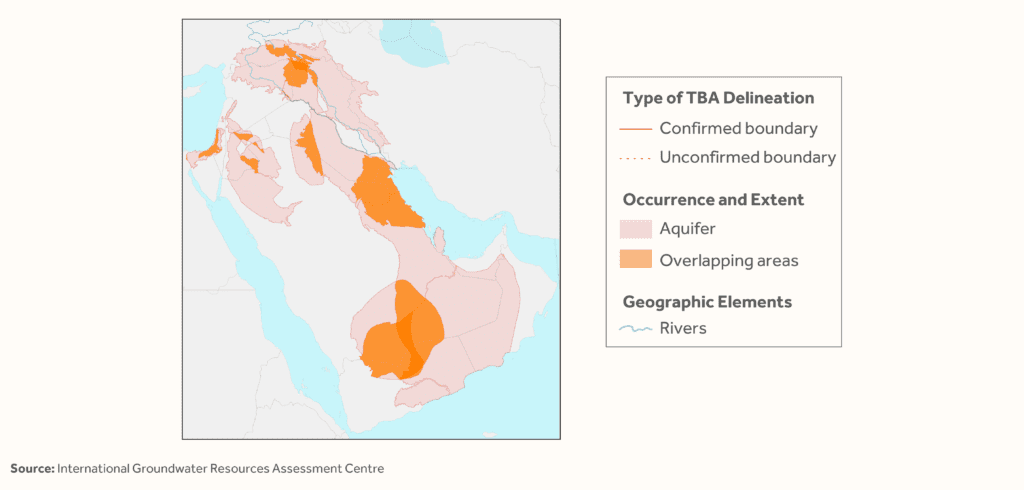
Source: International Groundwater Resource Assessment Center (IGRAC).26
In parts of the region, such as in Palestine, multilateral engagement must be preceded by reparative actions to ensure justice and accountability. Although this topic goes beyond the scope of this paper, it is important to mention the example of Palestinian communities under Israeli occupation, who suffer from Israeli state-sanctioned water theft from Palestinian aquifers (which are not transboundary and have historically been Palestine’s main source of freshwater). This has left the Palestinians with no control of their own water resources.27 The loss of access to their aquifers has forced many Palestinian communities to resort to collecting rainwater to survive, but the Israeli occupation forces have responded brutally by destroying Palestinian rainwater-harvesting cisterns.28 Such infringements cannot be resolved through diplomacy alone; other legal and enforcement mechanisms may be necessary to hold the Israelis accountable.
Case Studies in Water Diplomacy and Governance
The MENA region’s fragmented and incomplete network of water governance institutions is struggling to fulfill its purpose. This is primarily the result of mistrust, as well as governance gaps in this network, such as in the Tigris-Euphrates basin. There are also instances of transboundary water governance organizations struggling or failing, such as the Nile Basin Initiative. Other cases, particularly non-renewable transboundary aquifers, suffer from the “tragedy of the commons,”29 in which each country, intentionally or unintentionally, places its own interests before the common interests that it shares with other states. This, in turn, leads to the overuse of finite water resources and endangers the water security of all parties involved.
Case 1: The Tigris-Euphrates Basin and the Absence of Multilateral Water Governance
In the Tigris-Euphrates River Basin, there is no water governance institution bringing together the countries that share those two rivers (namely Iran, Türkiye, Iraq, and Syria).30 Unilateral actions by upstream states, particularly Türkiye, have also contributed to rising mistrust with its downstream neighbor, Iraq. To a lesser extent, Syria’s unilateral actions on the Euphrates have also damaged its relations with Iraq.
In the late 20th century, Syria’s General Administration for the Development of the Euphrates Basin (GADEB)31 and Türkiye’s Southern/Greater Anatolia Project (GAP)32 commissioned a series of dams that significantly reduced the flow of water to Iraqi communities that heavily rely on it for their economic and social lives. A comparable situation has emerged between Türkiye and Iraq on the Tigris River. In 2020-2021, poor rainfall in Iraq exacerbated the country’s water crisis to unprecedented levels, causing a reduction in water flow of 29% in the Tigris and 73% in the Euphrates.33
Damascus and Ankara’s excessive construction of dams without consistent coordination with Baghdad has created a water crisis for downstream Iraqi communities. For their part, there is no regional mechanism to hold Syria and Türkiye accountable for the impact of their actions on Iraq’s ability to access vital water resources.
Historically, 100 BCM of water flowed annually from the upper Tigris-Euphrates basin (primarily held by Türkiye) into Iraq.34 Today, largely due to upstream infrastructure projects, that amount has dwindled to 25 BCM annually, a 75% decline.35 Iraq is particularly vulnerable to the actions of upstream countries, because around 82% of its water comes from outside its borders (72% originates in Türkiye, part of which flows through Syria before reaching Iraq, while another 12% comes directly from Iran).36 As such, Iraqi officials concluded years ago that diplomatic engagement with upstream countries is their most important tool for resolving the current water crisis.37
In recent months, Iraq has sought to build trust with Turkish president Recep Tayyip Erdoğan in hope of resolving bilateral tensions over water resources.38 Starting on the bilateral track with Ankara is a sensible move and an acknowledgement of Türkiye’s disproportionate influence over Iraq’s water. However, without involving Syria and Iran in a wider multilateral push, Iraq will remain vulnerable to unilateral measures by any of its three upstream neighbors.
Case 2: The Nile Basin and the Pitfalls of Unfit Water Governance Institutions
Even where they exist, multilateral water governance institutions do not necessarily increase trust between member countries. A key example of this is the Nile Basin Initiative, which was created by the countries of the Nile Basin to facilitate cooperation and resolve disputes along Africa’s longest river. Previous attempted have not succeeded in reducing tensions between Egypt, Ethiopia, and Sudan over the Grand Ethiopian Renaissance Dam (GERD).<sup<39
There are two main reasons for this failure. First are structural and regulatory gaps, including the absence of an article in the institutional framework agreement that mandates prior notification of projects that will affect water flow.40 As such, notifications are only given as a matter of courtesy, meaning that Ethiopia was not obliged to inform Egypt about the GERD project in advance. This led to increased tensions between the two parties after Egypt became aware of the project. Moreover, Article 4 of the framework agreement, which discusses the equitable utilization of the Nile’s water resources, was amended by several members of the Nile Basin Initiative without unanimous consent, further alienating Egypt.41
In addition to discussions through the Nile Basin Initiative, Egypt, Sudan, and Ethiopia signed the 2015 Declaration of Principles on the GERD, which called for cooperation and trust-building.42 Subsequently, Ethiopia issued a notification to Egypt and Sudan when it initiated another filling of the dam.43 However, differing interpretations of the declaration (particularly the third clause on the principle of not causing significant harm) hampered progress in trust-building measures, meaning it has failed to evolve into an enforceable mechanism.
Secondly, as with Türkiye in the Euphrates-Tigris basin, Ethiopia has demonstrated a lack of political will to compromise with Egypt. For example, shortly after plans to construct the dam were announced in late 2010, former Ethiopian Prime Minister Meles Zenawi dismissed Egypt’s warnings about the national security implication of restricting water flow from the Blue Nile, saying “I am not worried that the Egyptians will suddenly invade Ethiopia… Nobody who has tried that has lived to tell the story. I don’t think the Egyptians will be any different and I think they know that.”44 Through its actions, Ethiopia demonstrated that it views any engagement over GERD as a matter of courtesy and has continued to warn Egypt against taking an aggressive approach.45 Egypt has thus far spent 13 years attempting to bring Ethiopia to the negotiating table with the help of international partners, but Addis Ababa has often responded by rebuffing Cairo’s efforts or withdrawing from negotiations before an agreement was reached (as was the case during 2023 talks in Washington).46 For its part, Ethiopia has stressed that the GERD project is a cornerstone of its development agenda and argued that international bias in favor of Egypt has hampered talks.47
Cairo is now considering recourse through international arbitration if it can prove that the GERD project infringes on its historical water rights. It is also actively working to bolster its military presence in the Horn of Africa, which Addis Ababa sees as an aggressive48 and worrisome escalation that further erodes prospects for a diplomatic resolution.49 Without a change in perspective in both capitals, and a more effective push from other involved parties, the situation is likely to worsen.
Case 3: Transboundary Aquifers and the Tragedy of the Commons
Transboundary aquifers are vital sources of water that often fall victim to the “tragedy of the commons,” especially because they tend to be non-renewable. Jordan and Saudi Arabia’s shared Al-Disi/Al-Saq aquifer is a prime example of this. When either of these two kingdoms increases the amount of water it extracts from this aquifer, the other does the same—even if it does not necessarily need the additional water.50 Therefore, despite signing a bilateral agreement to limit extraction, both Jordan and Saudi Arabia are using water from this aquifer for gratuitous agricultural projects that inefficiently produce water-intensive fruits and vegetables like watermelons, tomatoes, onions, and potatoes (although initial plans were focused on farming grain, which requires less water51).
This has created a dilemma with three bad options, although there is a “least bad” (i.e., optimal) option. If both sides continue to over-extract water, then the aquifer will deplete quicker than planned. If one side engages in over-extraction while the other does not, then the latter will feel that the situation is unfair. However, if both sides refrain from over-extraction (the optimal scenario), they will still need to address disgruntled domestic consumers who have grown accustomed to increased water allotments. For both sides to commit to refraining from over-extraction, they need to engage in trust-building exercises and abide by their negotiated bilateral agreement. In other words, despite their differences, the solution in this case resembles the two cases mentioned above.
MENA+ Water Forum: A Vision for Resolving Water Conflicts Through Regional Diplomacy
To avert the escalation of water conflicts in MENA, deeper multilateral engagement is needed. Regional organizations such as the Arab Water Council and the Arab League Council of Water Ministers should be empowered by Arab League countries to mediate wherever lower-level governance frameworks or bilateral diplomacy fail to resolve disputes. If those regional institutions also fail in mediating, then larger entities like the African Union (where applicable) or the United Nations can play a role. However, there is also room for creating a “MENA+ Water Forum” that includes neighboring non-Arab League members—particularly the upstream, riparian countries of the Nile (Ethiopia, South Sudan, and Uganda), the Tigris (Türkiye and Iran), and the Euphrates (Türkiye). No such forum currently exists to bring together this group of countries to discuss water affairs.
Currently, the Arab Water Forum, held every three years, is the largest regional forum in MENA where high-level officials engage directly on water issues. However, it does not regularly invite high-ranking representatives from the non-Arab upstream countries mentioned above. This hampers crucial discussions about the three largest rivers in the region, which flow from outside of it.
To implement an effective regional water diplomacy (and governance) framework, it is important to begin by setting common ground rules for all stakeholders, which would require diplomatic coordination on drafting policies and an organization framework that all parties agree to abide by. This would enable the creation of such an institution as the proposed “MENA+ Water Forum.”
In addition to providing space for diplomatic engagement, the “MENA+ Water Forum” can also provide space for organizing confidence-building measures to cultivate trust between countries. A good place to start is by increasing information exchange to close knowledge gaps and create a shared view about water resources in the region and beyond. The Gulf Cooperation Council (GCC)’s Water Sciences and Technology Association (WSTA) is a fitting example to emulate, as it has fostered consistent knowledge-sharing on water issues in the Gulf sub-region. A similar model should be deployed that includes the entire MENA region and neighboring countries like Ethiopia through the “MENA+ Water Forum.”
Successful confidence-building measures through information exchange can in turn lead to expanded technical collaboration and joint scientific research on water-related issues. Water scarcity in MENA cannot be mitigated solely through national programs; it requires the pooling of resources to implement regional transboundary initiatives. This includes creating joint monitoring centers to track water flow in shared river basins; collaborative research and development initiatives to find solutions to shared challenges; and regional academic and professional development programs to invest in the next generation of water experts.
There is also the challenge of financing, which could prove to be a deal-breaker for poorer countries in the region. Richer countries and international development organizations could mitigate this by creating a financing mechanism for poorer countries to assist in budgeting and strategizing around investment in shared projects. Richer countries could also take on a larger share of the burden when cooperating with poorer neighbors to develop a transboundary project.
International organizations can also play a role in fostering deeper cooperation on water between the MENA region and its neighbors. This could come in the form of training future experts and financing initiatives. To support the implementation of joint programs between lower- and middle-income countries, international aid could be provided by entities such as the International Development Association (IDA), the European Bank for Reconstruction and Development (EBRD), the African Development Bank (ADB), and the Islamic Development Bank (IDB), among others.
Additionally, organizations such as the United Nations Development Program (UNDP) could provide scholarships to support young professionals in the MENA region who want to develop skills in the water sector, which could then create spaces for future policymakers from around the region to meet and create new relationships. Some existing initiatives could serve as models, such as a recent ADB project that aims to enhance policy and strategic planning at the Nile Basin Initiative.52 This would in turn provide countries in the Nile River basin with an appropriate space to cooperate on transboundary projects and programs.
Conclusion
Diplomacy will be key to preventing the MENA region’s future water wars. Yet such diplomacy in water-scarce regions requires a shared understanding between parties that they need to cooperate to survive. Failure to do so could result in terrible consequences, destabilizing the region and beyond. This should inspire international actors to put more effort into supporting the MENA region in resolving its water challenges.
In the meantime, regional forums and mechanisms for de-escalation should work to highlight the importance of transboundary cooperation on water and to integrate non-Arab neighbors such as Türkiye, Ethiopia, and others in the region who share transboundary rivers and aquifers. Rivers and aquifers will continue to play a key role as strategic reserves of water, but they are currently being exploited in unsustainable ways. Desalination is not always the answer, and it cannot completely replace natural resources (let alone mitigate the loss of biodiversity resulting from shrinking rivers). Instead, the solution lies in deeper diplomatic engagement to resolve underlying conflicts, increased knowledge sharing, and joint projects between the MENA region and its neighbors to preserve shared water resources for future generations.



